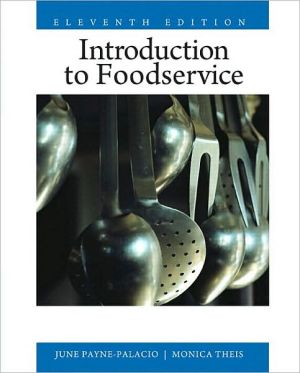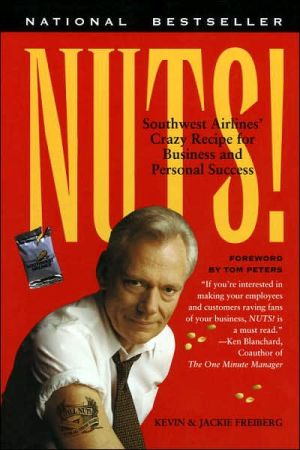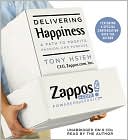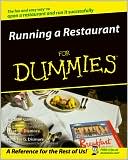Introduction to Foodservice
For courses in Introduction to Foodservice Management and Introduction to Food and Beverage Service.\ This 11th edition of a classic text has been revised and updated to include the latest and most relevant information in the field of foodservice management. It includes the basic principles of foodservice that can be applied to the operation of any type of foodservice. The impact of current social, economic, technological, and political factors on these operations is also included.\ \ \...
Search in google:
This 11th edition of a classic text has been revised and updated to include the latest and most relevant information in the field of foodservice management.It includes the basic principles of foodservice that can be applied to the operation of any type of foodservice. The impact of current social, economic, technological, and political factors on these operations is also included.Restaurant and banquet managers interested in current food service developments. Also, a good training tool for any worker in the food service industry. Booknews A text on all aspects of both noncommercial and commercial foodservice, for introductory courses in food service management. Coverage encompasses foodservice organizations, quantity food production and service, physical facilities, and organization and administration. Learning features include detailed key concepts, summaries, and review questions, plus a glossary, b&w photos, and appendices on cooking methods and equipment. This eighth edition contains new material on food safety, facilities management, and quality management, and comes with a new instructor's manual. Annotation c. by Book News, Inc., Portland, Or.
PREFACE: \ Preface\ Since the first edition of West and Wood's Introduction to Foodservice (then titled Foodservice in Institutions) was published in 1938, the authors have been committed to presenting the basic principles of foodservice management, which can be applied to all types of foodservice organizations. This ninth edition is no exception in giving comprehensive coverage of all aspects of foodservice management.\ Earlier editions, however, reflected the distinct difference that existed between commercial, or profit-seeking, organizations and noncommercial, or institutional, not-for-profit foodservice operations. Special emphasis was given to institutional foodservices: schools and colleges, hospitals and healthcare facilities, and in-plant or industrial foodservices.\ In recent years, a philosophical change has taken place—first gradually, then dramatically—in the management of many not-for-profit institutional foodservices. With rising healthcare costs of recent years and the pressures of healthcare reform, for example, hospitals have become more financially competitive in order to succeed and remain in business. Schools too, are under pressure to implement self-sustaining Child Nutrition Programs by offering revenue generating options such as à la carte lines and catering services and dinners. Today, most foodservices strive for some margin of profit, and make less of a distinction between the two types of foodservice. In response to these changes, the title of this book was changed with the seventh edition to Introduction to Foodservice.\ While the focus is on basic principles, this editionalso reflects the impact of current social, economic, technological and political factors on foodservice operations. Examples and illustrations reflect both noncommercial and commercial applications.\ FEATURES\ The pedagogical features included in this edition will help students, instructors, and other users maximize the value of this text. Of particular interest are the following:\ \ A case study runs throughout the entire book and allows students to apply the concepts presented through critical thinking questions.\ Each chapter concludes with a Summary and References.\ Review Questions at the end of each chapter help pinpoint the important concepts of the subject matter and serve as a study review and test for the reader, ensuring that the more important information is learned.\ Appendixes on Cooking Methods and Foodservice Equipment serve as ready references for the reader who seeks additional, detailed information.\ A running Glossary imbedded in chapter margins defines and more clearly explains some of the terms unique to this field of study. In the text, these terms are shown in boldface type.\ \ It is expected that users of this text will also supplement their reading with current journals, trade magazines, and research reports, as well as attend seminars and exhibits at conventions and trade shows to keep themselves up-to-date.\ Throughout this edition the material has been updated and revised to reflect current trends and practices. For example, branding and the branded concept as a marketing strategy are thoroughly discussed in Chapter 17. Many new photographs and illustrations are included to help visually interpret the subject matter. In addition, some chapter titles now incorporate new terminology to better reflect the subject matter.\ ORGANIZATION OF THIS EDITION\ Although it is unlikely that two teachers would organize the subject matter of this course in exactly the same way, we believe that the information in this text is presented in a logical sequence. First, the technical operation of a foodservice is discussed so that students will understand what is to be managed, and then the presentation of management techniques follows.\ Introduction to Foodservice is divided into four major parts. Part 1, "Foodservice Organizations," provides an overview. Chapter 1 gives a chronological review of the history of foodservice organizations, while Chapter 2 describes types of current foodservice operations.\ Part 2, "Quantity Food Production and Service," includes Chapters 3 through 8. This part begins with a chapter on food safety and is followed by a function-by-function description of a foodservice operation. These functions include menu planning, purchasing, production, and service. Each chapter includes factors that influence the management of that operational function.\ Part 3, "Facilities," is a four-chapter unit that focuses on the maintenance and design of the operational facilities. The unit begins with a chapter on sanitation and cleaning. Guidance is also offered on how to plan, design, and maintain a foodservice operation.\ Part 4, "Management," provides the reader with the basic knowledge to manage the operational functions of a foodservice. Chapter 13 covers the design and management of organizations. It is followed by a comprehensive chapter on human resource management. The unit concludes with chapters on professional qualities such as administrative leadership and skills including work improvement, financial management, and marketing.\ COURSES FOR WHICH THIS TEXT IS SUITABLE\ Although different schools may use this material in a sequence different from that presented here, the subject matter itself is appropriate for courses that include the following (with these or similar titles):\ \ Introduction to Foodservice Management\ Quantity Food Production\ Purchasing for Foodservices (both food and equipment)\ Organization and Management of Foodservices\ Facility Design and Equipment Arrangement\ Financial Design and Equipment Arrangement\ Food Protection and Safety\ Menu Planning for Foodservices\ Foodservice Marketing and Merchandising\ \ It is our hope that this newly revised edition of a classic text continues to meet the needs, as it has in the past, of the present generation of students who are preparing to become administrative dietetics, professionals, or foodservice managers. We hope, too, that teachers will find Introduction to Foodservice, Ninth Edition, a helpful guide and that foodservice managers in practice will use it as a ready reference in their work.\ ACKNOWLEDGMENTS\ Many people have assisted with the preparation of Introduction to Foodservice. Without their help, our task would have been impossible.\ The current authors are deeply appreciative of the excellent work of the original authors, Bessie Brooks West and LeVelle Wood, in providing a text that has been so widely accepted in the United States and abroad for more than 60 years. The text has been recognized for its authenticity and accuracy, a standard that we have striven to maintain in the new edition. Mrs. West assisted with revisions through the fifth edition, before she passed away in 1984 at the age of 93. Miss Wood was active in all revisions through the sixth edition. She died on January 31, 1997. Grace Shugart and Virginia Harger retired as co-authors following publication of the seventh edition. Ms. Shugart passed away in 1995. Ms. Harger has enjoyed an active retirement in Oregon and plans to move to Spokane to be near family and friends.\ We are grateful to the peer reviewers, who challenged our thinking and made excellent suggestions for changes or additions to the first drafts of the manuscripts. Their comments were honest and open, and many of their ideas have been incorporated into the text. We believe that their input has made the text even more meaningful to our readers.\ The following individuals helped in special ways in the preparation of this edition. To each of them we are greatly indebted and give our thanks.\ The Administrative staff at Madison Metropolitan School District, especially Iris Torado and Frank Kelly, for their contributions to the case studies.\ Secretarial staff of the Department of Food Science, University of Wisconsin-Madison, for their work on the manuscript. Special thanks to Sarah Grant and Suzanne Smith.\ We would like to express special thanks to our editorial staff and production staff at Prentice Hall for their patience in working with us, and for giving encouragement for the completion of this revision. Finally, we wish to acknowledge the support and encouragement of our families and special friends who have endured the countless hours we have devoted to this work. We express our special love and appreciation to Monica's husband, Craig Schiestl, and daughter Emma, and June's husband, Moki, who passed away in June of 1999. We dedicate this edition to his memory.\ June Payne-Palacio\ Monica Theis
1Foodservice Organizations11The Foodservice Industry32Types of Foodservice Operations282Quantity Food Production and Service473Food Safety494The Menu: The Focal Point of the Foodservice Operation875Purchasing, Receiving, and Storage1156Production Management1667Assembly, Distribution, and Service1993Physical Facilities2278Cleaning, Sanitation, and Facility Safety2299Environmental Management26610Facilities Planning and Design27911Equipment and Furnishings3324Organization and Administration36312Designing and Managing the Organization36513Staffing and Managing Human Resources39114Administrative Leadership43315Work Improvement and Productivity45716Financial Management48517Marketing and Promotions in Foodservice Organizations521Appendix APrinciples of Basic Cooking543Appendix BFoodservice Equipment556
\ BooknewsA text on all aspects of both noncommercial and commercial foodservice, for introductory courses in food service management. Coverage encompasses foodservice organizations, quantity food production and service, physical facilities, and organization and administration. Learning features include detailed key concepts, summaries, and review questions, plus a glossary, b&w photos, and appendices on cooking methods and equipment. This eighth edition contains new material on food safety, facilities management, and quality management, and comes with a new instructor's manual. Annotation c. by Book News, Inc., Portland, Or.\ \








